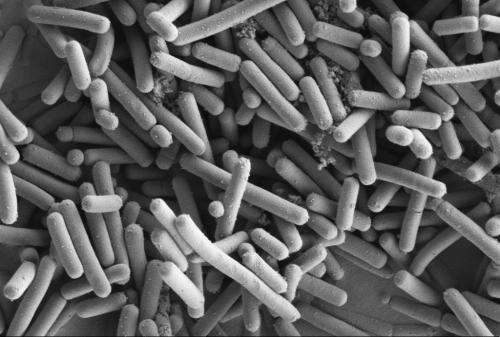Poultry probiotic cuts its coat to beat bad bacteria

A strain of probiotic bacteria that can fight harmful bacterial infections in poultry has the ability to change its coat, according to new findings from the Institute of Food Research.
The probiotic is currently being taken forward through farm-scale trials to evaluate how well it combats Clostridium perfringens – a cause of necrotic enteritis in poultry and the second most common cause of food poisoning in the UK
The researchers at IFR, which is strategically funded by the Biotechnology and Biological Sciences Research Council, had previously found that the probiotic Lactobacillus johnsonsii, when given to young chicks, prevents the colonisation of C. perfringens. Now, in research published in the journal PLOS ONE, they have found that the probiotic bacteria have the ability to alter their coat. They speculate that this could be one way in which the probiotic outcompete C. perfringens.
The researchers noticed when examining the bacteria that a small number of them appear smooth. They identified genes responsible for making a special coat, or slime capsule, which the bacteria surround themselves in. This protects the bacteria from stomach acids and bile salts, and helps them come together to form biofilms. It may also protect against drying out when outside the host. The natural appearance of smooth mutants could be a ploy used by the bacteria to introduce variation into its populations, making them able to take advantage of different environments.
By turning off one or more of the coat genes, they could see what effect this had on its ability to stick to gut tissues. "The next step is to understand the regulation of the genes involved in making the coat" said Dr Arjan Narbad, who led the studies. "We want to find out whether changing the coat affects the probiotic's fitness to colonise and inhabit the gut."
This in turn could prevent C. perfringens from colonising the gut. This competitive exclusion could be one reason why the probiotic strain prevents the growth of other harmful bacteria.
Understanding the role of the slime capsule coat will inform the commercial development of this strain as a preventative treatment for C. perfringens infection in poultry, especially in regard to how the probiotic is stored and produced. Through the technology transfer company Plant Bioscience Ltd, the strain has been patented and is now in large-scale farm trials to assess its efficacy. As these bacteria have previously been used in the food chain and are considered safe for human consumption, this probiotic strain could become new way of controlling C. perfringens.
As there is a growing pressure to reduce the use of antibiotics in farming, new products are needed to maintain animal welfare standards, reduce the huge costs of necrosis in poultry and help keep our food safe.
More information: Spontaneous mutation reveals importance of exopolysaccharide to Lactobacillus johnsonii surface charcteristics, PLOS ONE, dx.plos.org/10.1371/journal.pone.0059957
Journal information: PLoS ONE
Provided by Norwich BioScience Institutes













